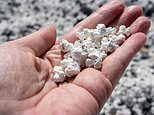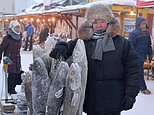
Feeling the sand beneath your toes doesn’t quite go to plan on ‘popcorn beach’, a stretch of coast in the Canary Islands where the grains are…sizeable.
Playa del Bajo de la Burra sits on the north coast of Fuerteventura and has become a tourist attraction purely for the very unique texture of what beach-goers feel underfoot.
The natural phenomenon has seen time and erosion create a unique knobbly sand that looks remarkably similar to what you’d find behind the snack counter at the cinema.
The small nugget-like formations cover the entire beach, which means ‘beach of the donkey’s underbelly’ in Spanish, and are known scientifically as rhodoliths.
Made from calcareous algae and white sand, they’ve been growing underwater for millennia, with waves and the sun’s rays casting them into their small, white, bulbous form.
They’re also intermingled with the black sand and volcanic rocks that the Canary Islands, off Africa’s west coast – a four-hour flight from the UK – are famous for.
The beach is close to the town of Corralejo in the municipality of La Oliva, with other beaches along the same stretch of coast on the Canary Island also having the same sand.
Playa del Bajo de la Burra has become more known for its surreal coral-like sands, a hit with TikTokers, than it has for swimming – with the choppy Atlantic waters often dangerous for bathing.
Pieces of white broken corals on the beach at Playa del Bajo de la Burra do a very good impression of a handful of popcorn
The wild beach has become a tourist attraction thanks to its unique rhodolith formations, which have been moulded by time and weather
And there are no sun loungers either; Popcorn Beach is very much a wild spectacle to be admired while on a hike or cycle of the rugged coast.
Behind Tenerife, Fuerteventura is the second largest of Spain’s Canary Islands, which sit in the Atlantic ocean, a mere 100km off Africa’s north-west coast.
It’s also the oldest Canary Island, with its terrain formed by volcanic activity up to 30 million years ago.
The island’s reliable winter weather – around 21 degrees in December – comes from the fact the island is closer to Africa than to Spain.
In recent decades, Fuerteventura has been used as a filming location for some big-budget movies thanks to its otherworldly landscapes, which are arid, rocky and mountainous.
Ridley Scott’s Exodus: Gods And Kings, starring Christian Bale, as well as Brad Pitt in Marion Cotillard’s Second World War drama Allied, where the island doubled as North Africa.
On the coast, watersports fans take advantage of the island’s strong winds and rolling Atlantic waves; while nature lovers come to spot barbary falcons, Egyptian vultures and chipmunks.
Share or comment on this article:
The stunning Spanish beach with ‘popcorn sand’
Source link
CHECK OUT: Top Travel Destinations
READ MORE: Travel News



